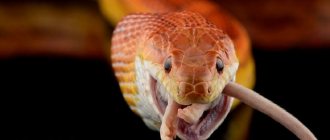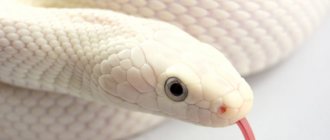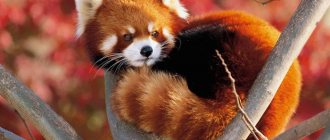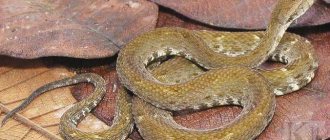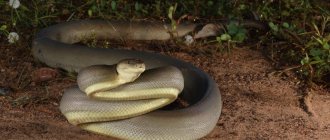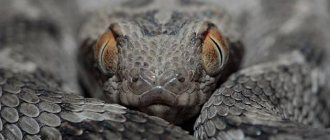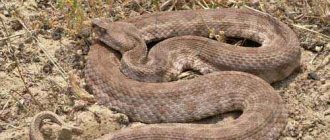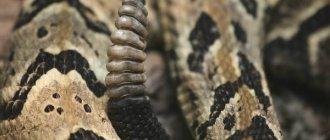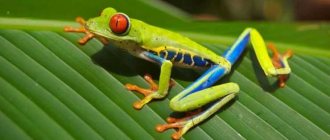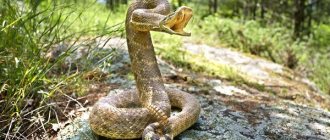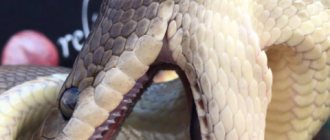Snakes fascinate with their beauty, mystery and incredible calm. The calmness of snakes is paired with their fury during an attack - this trait gives snakes their charm. Motley-colored snakes attract special attention because, in addition to beauty, they carry the destructive power of their poison.
To get to know these snakes better, look at photos of red snakes on the Internet.
Common viper
One of the red poisonous snakes is the common viper. The viper may have a red-brown color. The body most often has a length of up to 75 cm. The body is monochromatic, and a zigzag stripe can be traced on the back. The head with large eyes equipped with rod-shaped pupils is clearly distinguishable in comparison with the body.
It lives in the far eastern and European parts of Russia. Lives in stumps, bushes and burrows. They breed during the last month of spring, and life can last up to fourteen years.
Snakes are poisonous, but prefer to run away from a person rather than attack him. Although at night they can crawl to the fire and even climb into the tent of vacationers.
Diet of coral adder
In natural, natural conditions, the coral adder feeds mainly on various types of amphibians, as well as fairly large insects or small lizards.
At home, when kept in a terrarium, the adder's main diet should be small rodents, including mice and rats. You can also use the largest species of cockroaches, including Madagascar cockroaches, as food.
Important! It is advisable to feed the coral adder a couple of times a week, which will prevent overfeeding your pet.
A feature of the species when kept in captivity is its susceptibility to obesity. It is imperative to regularly add basic vitamin and mineral complexes to the coral adder’s food. There should always be fresh and clean water in the drinking bowl.
Tiger snake
In the Far East of Russia you can find the tiger snake. This snake is predominantly green in color, with red stripes visible closer to the snake's head. The tiger snake's body reaches a meter in length.
The snake secretes a special secretion that has the ability to scare away predators that pose a danger to the reptile. The tiger snake lives in humid environments and prefers to feed on fish, toads and frogs.
Popular and harmless
If on your way you come across a yellow snake, or more precisely, a reptile with characteristic markings of this color on its head, then most likely this is an ordinary one. Snakes of this species are the most common; they can be found in every corner of our planet. Variations in their color and size may differ slightly, but in general it can be easily determined by knowing its main external characteristics:
- Snakes have a uniform back color. from dark green to greenish-gray.
- The head is not too wide; it flows smoothly from the body, without noticeable expansion.
- The grass snake is a snake with yellow spots on its head, which are located on its sides. A little less often they can be white or beige.
- The size of common snakes varies from 50 to 80 centimeters in length, the diameter does not exceed 5 centimeters.
The named reptile chooses a humid climate with a lot of stones, stumps or branches to hide. Therefore, the greatest likelihood of meeting these snakes is on the shores of reservoirs and forest lakes. Also, these snakes are excellent swimmers, so if you come across a snake while swimming in a pond, don’t panic, most likely it’s just a snake. He is not aggressive, he can bite a person only for the purpose of self-defense, and his bite is absolutely harmless and shallow.
Why do you dream about a red snake?
A snake of an intense red hue is subconsciously associated in humans with danger. Thus, meeting a red snake in a dream may indicate that troubles are expected, such as troubles at work, quarrels with loved ones or any other problems.
Note!
- Domestic turtles - the most popular species, cultivation features, tips for care and maintenance (115 photos + video)
- Indian snakes: sacred, poisonous, most common and dangerous types of Indian snakes and their names (130 photos)
Small snakes - an overview of popular and rare species, habitats, food and names of snakes (115 photos)
If in a dream you show aggression towards this creature, we are talking about your persistence, determination and even some aggression.
Snakes writhing in a ball can indicate your distrust of your surroundings and the presence of gossip that hovers around your person.
In addition, a club of snakes can talk about hypochondria: you are probably too afraid of getting sick with something, although if you suspect health problems, a visit to the doctor will not be superfluous.
Interpretation in various dream books
The image of a snake is one of the most controversial. Interpretations of sleep in dream books often differ. Intuition will help you decipher the dream.
Miller
You can't be too trusting. Perhaps the dreamer is sharing unnecessary experiences in vain. The sleeper holds a reptile in his hands - to worries related to the family.
Aesop
The reptile is sleeping - there is a dangerous person nearby who has intentions of causing harm. The snake shed its skin - to recovery after a long illness.
An aggressive reptile is a sign that those around you are unhappy with the dreamer.
Nostradamus
Viper:
- looks intently - the attention of authoritative people is riveted to the dreamer
- puts pressure on the neck - caution must be exercised as the risk of accidents increases
- stretched out - for adventure
Vanga
The dream predicts deception, betrayal and betrayal.
Freud
The dream represents fear of sexual intercourse. Perhaps the woman had a sad experience of rape, or the man was unable to perform well in bed.
Loff's interpretation
The dreamer had no fear of the yellow snake - many good events were coming. Perhaps it's time to start life from scratch. A reptile bite means poverty.
Longo
A yellow snake swims through the water - you will have to deal with an unpleasant person. Receiving a snake as a gift is a sign of joy and fun.
Hasse
There will be reconciliation after a long quarrel. A snake crawled into bed - you will be able to pay off your financial debt.
Medea
The reptile has shed its skin - you are about to meet a wise person. It will have a strong influence on the dreamer.
Psychological interpreter Furtseva
Destroying a nest with yellow snakes means that in reality you will be able to get rid of an obsessive person.
Big dream book of Natalia Stepanova
The dream warns of problems at work: reprimands, fines, dismissal.
Wanderer
The poisonous yellow snake represents destructive power, but everything depends on its behavior. Reptile:
- crawls towards the dreamer - to gain access to secret knowledge
- bites - to illness
- dies - good news
According to Jung
The image has a phallic meaning. In some cases, dreams represent the unconscious, internal anxieties and fears.
Tsvetkov
A yellow snake wraps itself around the body of a girl or guy - there are many envious people around them. A child is playing with a reptile - the dreamer will have information at his disposal that will surprise him.
A yellow snake hanging on a tree means your health will worsen.
Simon the Canaanite
A married man saw a dream - the birth of a son.
Dream Interpretation Meneghetti
The dream warns of fatigue, loss of strength, and apathy.
According to Azar
A snake bite means litigation. Buying a reptile is a sign of a pleasant time with friends.
According to Ivanov
The sleeper will soon suffer from the machinations of an evil person. The snake has bitten - the enemy will achieve his goal.
According to Grishina
The image symbolizes contradictions and deception.
According to Dmitrienko
The yellow snake is a symbol of wisdom and vitality.
Interpreter of Solomon
The dream warns of troubles.
Dream Interpretation of Catherine the Great
If you step on a viper, you will have to communicate with an unpleasant person. A snake bite warns of difficulties at work, including dismissal.
Healers Akulina
A snake crawls through the grass - good news. A reptile bite warns of high competition in a team. The snake died - to a successful solution to difficulties.
Tiflisi
The dream symbolizes interference, delay and obstacles in concluding deals.
Phoebe
The snake bit - to a showdown, crawled into the house - to a strong quarrel with the family.
Maly Velesov
A reptile on a tree means there is a high risk of falling for scammers. Stepping on a snake means the dreamer is heavily slandered.
Romantic
An insidious rival will appear on the horizon. A close friend will probably betray you.
Dream book of the 21st century
A yellow snake has wrapped itself around the dreamer’s neck and he is suffocating - marriage should be postponed. Seeing a reptile crawling into a pocket or under clothing means the birth of a son.
Children's
The dream represents anger, gossip, useless fuss.
Lunar
The interpretation depends on the phase of the moon:
- the heavenly body is growing - to a conflict between people of different generations
- decreases - relationships with relatives will worsen
- full moon - to difficult times and troubles
- new moon - to exacerbation of the disease
Esoteric
The yellow snake is a symbol of unusual abilities. Perhaps the dreamer has the gift of healing people or predicting the future.
Modern
The dreamer has made friends with a snake, or a reptile has simply crawled past - it will be possible to cope with difficult life circumstances. In any situation, the dreamer will be the winner.
Love
The dream warns of impending disagreements between a man and a woman. It will be difficult to restore the relationship.
Creative
A series of events will occur that will cause the dreamer to become disillusioned with the relationship.
Dream Interpretation of the Subconscious
Killing a snake means new responsibilities arise. A ball of snakes warns of great danger.
Russian folk
The ill-wisher will soon reveal himself and he will be exposed.
Slavic dream book
All difficulties will soon be overcome. People who are sick will soon be healed.
Islamic dream book
The enemy is influential and rich. Using superiority, he will seek to destroy the dreamer's life.
Muslim
There will be conflicts with relatives over property. You may have to start buying or selling a home.
The problem may worsen, and litigation between relatives will begin.
American
A dream involving a yellow snake warns of changes in mood.
French
There will be a short separation. The problems are temporary, everything will fall into place soon.
Chinese interpreter
Seeing a yellow snake is lucky. The longer the reptile, the better the dreamer’s financial well-being.
Icelandic
Killing a reptile means the triumph of justice.
Ancient Egyptian
A snake bite is a warning about someone else's enmity and hostility.
Photo of a red snake
Family of blind snakes
It is distinguished by a worm-like structure, adapted to living in the ground. The tail is short, with a spine at the end, on which the snake rests when moving. The eyes are reduced, covered with an eye shield, and covered with skin.
Brahminical Slepun
A miniature snake, 12 cm long, loves to live in flower pots on the street, for which it is nicknamed the potted snake. So she travels all over the world.
Barbados narrowmouth snake
A rare species of the smallest snake, only 10 cm long, on the verge of extinction. The area where they live is shrinking due to deforestation. The life of mini snakes is short - from spring to late autumn. One egg laid as offspring puts the population at risk.
Giant blind fledgling
In the family, the snake is considered a real giant - its body length is up to 1 meter. A harmless creature living underground in Central Africa. Endlessly digs the ground in search of larvae in termite mounds. Working with its head and resting on its tail spike, the blind beetle quickly moves through the loose soil. Avoids rocky places.
Worm-like blind snake
The main habitats are tropics and subtropics. The creature is harmless to humans. Externally, the snake looks like a large earthworm. You can find it among the roots of trees, between stones. The entire body is covered with tiny scales. When in danger, I emit an unpleasant odor.
Habitats of the ribbon krait
The ribbon krait lives in both moderately humid and dry places. However, a prerequisite for snakes to live is the presence of a variety of shelters - burrows, piles of dead wood, thickets of bushes near which the krait hunts. Krayt can also be found on agricultural lands, in human yards and homes. In areas with high population density, they are not so common, although they can appear in the house. During the daytime, pama most often avoids the sun, hiding in their shelters.
Lifestyle of Ribbon Kraits
The ribbon krait is nocturnal. During the day, he prefers to hide in dry holes or under tree roots.
Ribbon krait (Bungarus fasciatus).
If you catch it, it does not offer any resistance; you can throw it, shake it, or hold it in your hands. But when night falls, mom crawls out to hunt. Sensitive thermoreceptors detect the heat of prey within a radius of 5-7 meters, and the snake is rarely left without prey.
Links[edit]
Quotes [edit]
- ^ a b "Pseudechis porphyriacus". IUCN Red List of Threatened Species
.
2017
: e.T42493274A42493282. 2022. doi: 10.2305/IUCN.UK.2018-1.RLTS.T42493274A42493282.en.| date = / | doi = mismatch - ^ abc Australian Biological Resources Survey (26 August 2013). "Species Pseudechis porphyriacus (Shaw, 1794)". Handbook of Australian Fauna
. Canberra, Australian Capital Territory: Australian Government Department of Environment, Water, Heritage and the Arts. Retrieved December 6, 2022. - Pseudechis porphyriacus
species in the Reptile Database. www.reptile-database.org. - ^ abc Shaw, George (1794). Zoology of New Holland. London, UK: J. Sowerby. pp. 27–28.
- ^ a b Williams, David; Wüster, Wolfgang; Fry, Brian Grieg (2006). "The good, the bad and the ugly: Australian snake taxonomists and the history of Australian venomous snake taxonomy". Toxicon
.
48
(7): 919–30. DOI: 10.1016/j.toxicon.2006.07.016. PMID 16999982. - Jump up
↑ Liddell & Scott 1980, p. 579. - Lacépède, B. G. E. (1804). "Mémoire sur plusieurs animaux de la Nouvelle-Hollande dont la description n'a pas encore été publiée". Annales du Muséum National d'Histoire Naturelle. Paris
.
4
: 184–211 [209], [pl. 56 pics 1]. - Lesson, R.P. (1826). "Reptiles". . In Duperrey, L. I. (ed.). Voyage Autour du Monde, Exécuté par Ordre du Roi, sur la Corvette de sa Majesté, La Coquille, Pendant les Années 1822, 1824 and 1825. Zoologie, Atlas
. Paris: Arthus Bertrand. - Schlegel, Hermann (1837). Essai sur la Physionomie des Serpens. Partie Générale et Partie Descriptive (in French). 2
. La Haye: Kips and Stockum. pp. 479–80. - Table X from: Zoology and Botany of New Netherland and Adjacent Islands
/ Zoological Part by George Shaw, Botanical Part by James Edward Smith; figures by James Sowerby. - Wagler, Johann Georg (1830). Natürliches System der Amphibien, mit vorangehender Classification der Säugethiere und Vogel (in German). Munich, Germany: Cotta'schen. paragraph 171.
- McKay, Roy D. (1953–54). "Revision of the genus Pseudechis". Proceedings of the Royal Zoological Society of New South Wales
.
74th
: 15–23. - Jump up
↑ Liddell & Scott 1980, p. 795. - Jump up
↑ Liddell & Scott 1980, p. 295. - Worrell, Eric (1961). "Herpetological name changes" (PDF). Western Australian Naturalist
.
8
: 18–27. Archived from the original (PDF) on March 19, 2012. Retrieved January 17, 2012. - Maddock, Simon T.; Childerston, Aaron; Fry, Brian Grieg; Williams, David J.; Barlow, Axel; Wüster, Wolfgang (2017). "Multilocal phylogeny and species delimitation of Australo-Papuan black snakes (Pseudechis Wagler, 1830: Elapidae: Serpentes)" (PDF). Molecular phylogenetics and evolution
.
107
: 48–55. DOI: 10.1016/j.ympev.2016.09.005. hdl: 2436/621498. PMID 27637992. - ^ ab Hoser, Raymond (2003). "Reassessment of the taxonomy of Red-bellied black snakes (genus Pseudechis) with descriptions of two new subspecies" (PDF). Boydii - Journal of the Herpetological Society of Queensland
(Autumn (May)): 15–18. - Kaiser, Hinrich; Crother, Brian I.; Kelly, C.M.R.; Luiselli, Luca; O'Shea, Mark; Ota, Hidetoshi; Passos, Paulo; Schleip, Wulf D.; Wüster, Wolfgang (2013). "Best Practices: In the 21st Century, taxonomic decisions in herpetology are only acceptable if they are supported by a body of evidence and published through peer review" (PDF). Herpetological Review
.
44
(1): 8–23. - ^ abcdefghijklmnop Beatson, Cecily (5 May 2017). "Red-bellied Black Snake". Australian Museum website
. Australian Museum. Retrieved May 19, 2022. - Troy, Jakelin (1993). Sydney Language (PDF). Canberra: self-published. paragraph 53. ISBN 0-646-11015-2.
- ^ ab Sutherland & Tibballs 2001, p. 139.
- ^ abc Australian Reptile Park. "Red-bellied Black Snake". Somersby, New South Wales. Archived from the original on January 3, 2008. Retrieved December 28, 2007.
- Australian Broadcasting Corporation (3 October 2014). "Huge Red-bellied Black Snake Surprises Newcastle Wrangler Called to Remove It". ABC News
. Retrieved December 4, 2022. - Jump up
↑ Greer 1997, p. 163. - Bennett, George (1860). A Naturalist's Collection in Australasia: Observations Chiefly on the Animals and Plants of New South Wales, New Zealand, and Some of the Islands of Australia. London: J. Van Vorst. pp. 274–76.
- Krefft, Gerard (1869). Snakes of Australia: An Illustrated and Descriptive Catalog of All Known Species. Sydney, NSW: T. Richards, Government Printing Office. pp. 46–47.
- Hutchinson, Mark; Williams, Ian (2018). "The Key to the Snakes of South Australia" (PDF). South Australian Museum
. Government of South Australia. Retrieved February 8, 2022. - Macdonald, Stuart. "searching for the snake scale counter". Online Database of Australian Reptiles
. Retrieved May 3, 2022. - ^ ab Sutherland & Tibballs 2001, p. 140.
- ^ B s d e e Shoe, Richard (1987). "Intraspecific differences in thermoregulation, locomotion and habitat use of Australian black snakes, Pseudechis porphyriacus (Elapidae)" (PDF). Journal of Herpetology
.
21
(3): 165–77. DOI: 10.2307/1564479. JSTOR 1564479. - Mirtschin, Rasmussen & Weinstein 2022, p. 116.
- ^ ab Gilbert, Pennsylvania (1935). "Black Snake". Proceedings of the Royal Zoological Society of New South Wales
.
55
: 35–37. - ^ ab Greer 1997, p. 139.
- ^ abc Mirtschin, Rasmussen & Weinstein 2022, page 117.
- Jump up
↑ Greer 1997, p. 140. - Mirtschin, Rasmussen & Weinstein 2022, p. 43.
- Ormsby, A. I. (1952). "Notes on Snake Hibernation in New South Wales". Proceedings of the Royal Zoological Society of New South Wales
.
71
: 25–27. - Hoser, Raymond T. (1980). "Further records of assemblages of various species of Australian snakes". Herpetofauna
.
12
(1): 16–22. - Shine On, Richard; Grigg, Gordon C.; Shine, Terry J.; Harlow, Peter (1981). "Mating and male combat in Australian black snakes, Pseudechis porphyriacus" (PDF). Journal of Herpetology
.
15
(1): 101–07. DOI: 10.2307/1563652. JSTOR 1563652. - ^ abcd Sutherland & Tibballs 2001, p. 141.
- Cogger, Harold G. (1983) [1979]. Reptiles and Amphibians of Australia
(Rev. ed.). Reid. item 449. ISBN. 978-0-88359-048-5. - Shine, Richard (1978). "Growth rates and sexual maturation of six species of Australian cartilaginous snakes". Herpetologica
.
34
(1):73–79. JSTOR 3891614. - ^ ab Eipper, Scott (2012). Guide - Australian Snakes in Captivity: Elapids & Colubrids
. Reptile Publications. item 237. ISBN. 978-0-9872447-8-9. - Jump up
↑ Greer 1997, p. 145. - ^ ab Greer 1997, p. 147.
- Phillips, Ben L.; Shine On, Richard (2006). "An invasive species causes rapid adaptive changes in a native predator: cane toads and black snakes in Australia". Proceedings of the Royal Society B: Biological Sciences
.
273
(1593): 1545–50. DOI: 10.1098/rspb.2006.3479. PMC 1560325. PMID 16777750. - Broad, A.J.; Sutherland, UK; Coulter, A. R. (1979). "The lethality of dangerous Australian mice and other snake venoms." Toxicon
.
17
(6): 661–64. DOI: 10.1016/0041-0101 (79) 90245-9. PMID 524395. - Johnston, Christopher I.; Ryan, Nicole M; Page, Colin B; Buckley, Nicholas A; Brown, Simon G.A.; O'Leary, Margaret A; Isbister, Geoffrey K. (2017). "Australian Snakebite Project, 2005–2015." (ASP-20)" (PDF). Medical Journal of Australia
.
207
(3):119–25. DOI: 10.5694/mja17.00094. LVP: 1959.13 / 1354903. PMID 28764620. S2CID 19567016. - ^ abc Mirtschin, Rasmussen & Weinstein 2022, page 119.
- Mirtschin, Rasmussen & Weinstein 2022, p. 101.
- ^ ab Mirtschin, Rasmussen & Weinstein 2022, p. 110.
- Weinstein, Scott; Mircin, Peter J.; Tristram, Hamish; Lawton, Luke; White, Julian (2018). "Local morbidity from envenomation
by the red-bellied black snake (
Pseudechis porphyriacus
, Elapidae): two cases and a summary of treatment."
Toxicon
.
142
: 34–41. DOI: 10.1016/j.toxicon.2017.12.047. PMID 29269114. - ^ ab Churchman, Andrew; O'Leary, Margaret A; Buckley, Nicholas A; Page, Colin B; Tankel, Alan; Gavaghan, Chris; Holdgate, Anna; Brown, Simon G.A.; Isbister, Geoffrey K. (2010). "Clinical effects of red-bellied black snake (Pseudechis porphyriacus) envenomation and correlation with venom concentration: Australian Snakebite Project (ASP-11)". Medical Journal of Australia
.
193
(11):696–700. DOI: 10.5694/j.1326-5377.2010.tb04108.x. PMID 21143062. S2CID 15915175. - Vaughan, Gary T.; Scully, Thomas B.; Tyrrell, Roy (1981). "Isolation of a hemolytic toxic phospholipase from the venom of the Australian red-bellied black snake ( Pseudechis porphyriacus
)".
Toxicon
.
19
(1):95–101. DOI: 10.1016/0041-0101 (81) 90121-5. PMID 7222091. - Schmidt, J. J.; Middlebrook, J. L. (1989). "Purification, sequencing and characterization of pseudodexine phospholipases A2 from Pseudechis porphyriacus
(Australian red-bellied black snake)".
Toxicon
.
27
(7): 805–18. DOI: 10.1016/0041-0101 (89) 90048-2. PMID 2675391. - Sutherland & Tibballs 2001, p. 142.
- Heller, J.; Bosward, K. L.; Hodgson, JL; Cole, Florida; Reid, South Africa; Hodgson, D. R.; Mellor, D. J. (2005). "Snake poisoning in dogs in New South Wales". Australian Veterinary Journal
.
83
(5):286–92. DOI: 10.1111/j.1751-0813.2005.tb12743.x. PMID 15957391. - Heller, J.; Bosward, K. L.; Hodgson, D. R.; Potti, R. (2006). "Anuric renal failure in a dog following red-bellied black snake (Pseudechis porphyriacus) envenomation". Australian Veterinary Journal
.
84
(5): 158–62. DOI: 10.1111/j.1751-0813.2006.tb12769.x. PMID 16739524.
Books cited[edit]
- Greer, Allen E. (1997). Biology and evolution of Australian snakes
. Chipping Norton, NSW: Surrey Beatty and Sons. ISBN 978-0-949324-68-9. - Liddell, Henry George; Scott, Robert (1980) [1871]. Greek-English Lexicon (Abridged Edition). Oxford, United Kingdom: Oxford University Press.
- Mirchin, Peter; Rasmussen, Arne; Weinstein, Scott (2017). Australia's dangerous snakes: identification, biology and envenomation
. Clayton South, Victoria: Csiro Publishing. ISBN 978-0-643-10674-1. - Sutherland, Struan K.; Tibballs, James (2001) [1983]. Australian Animal Toxins
(2nd ed.). South Melbourne, Victoria: Oxford University Press. ISBN 978-0-19-550643-3.
Classification
Species of the genus Krayt:
- Andaman krait (Bungarus andamanensis);
- Kantor's krait (Bungarus bungaroides);
- Malayan krait (Bungarus candidus);
- Indian krait (Bungarus caeruleus);
- Ceylon krait (Bungarus ceylonicus);
- lead krait (Bungarus lividus);
- ribbon krait (Bungarus fasciatus);
- yellow-headed krait (Bungarus flaviceps);
- black krait (Bungarus niger);
- large-spotted krait (Bungarus magnimaculatus);
- South China multibanded krait (Bungarus multicinctus);
- Bungarus sindanus.
The most common species is the pama (ribbon krait), found in India, Burma and southern China. The most dangerous of this genus is the yellow-headed krait (noted above), which has small teeth but the most deadly poison.
